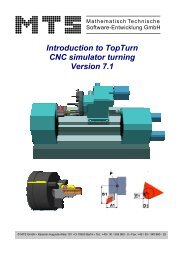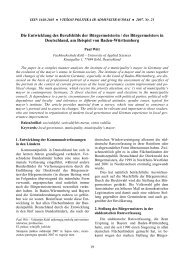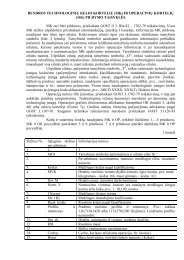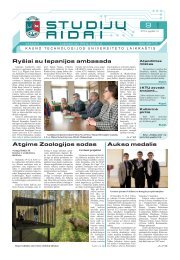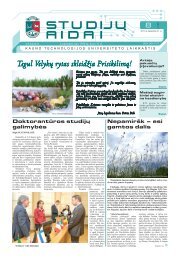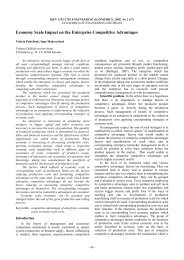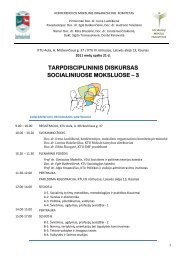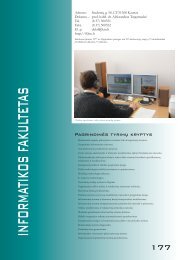cement based foam concrete reinforced by carbon nanotubes
cement based foam concrete reinforced by carbon nanotubes
cement based foam concrete reinforced by carbon nanotubes
You also want an ePaper? Increase the reach of your titles
YUMPU automatically turns print PDFs into web optimized ePapers that Google loves.
Table 1. Physico-mechanical characteristics of <strong>cement</strong> <strong>foam</strong> <strong>concrete</strong><br />
№<br />
Amount of <strong>nanotubes</strong>,<br />
% <strong>based</strong> on the<br />
composition mass<br />
Average<br />
density,<br />
kg/m 3<br />
Compressive<br />
strength,<br />
MPa<br />
Heat conductivity<br />
coefficient, λ,<br />
W/mK<br />
Pore<br />
diameter,<br />
μm<br />
Condition of<br />
wall pores<br />
1 0 330 0.18 0.07 40 – 600 perforated<br />
2 0.05 309 0.306 0.056 60 – 150 homogeneous<br />
a b c d<br />
Fig. 6. Cement <strong>foam</strong> <strong>concrete</strong> structure: a – without <strong>nanotubes</strong>, b – with 0.05 % <strong>nanotubes</strong>; pore walls; c – without <strong>nanotubes</strong><br />
(perforated), d – stabilised with addition of 0.05 % of <strong>nanotubes</strong><br />
physico-mechanical properties of the prepared specimens<br />
(100×100×100) mm were determined <strong>by</strong> the standard<br />
methods and the results are given in Table 1.<br />
As we can see from Table 1, the modification of<br />
<strong>cement</strong> <strong>foam</strong> <strong>concrete</strong>s <strong>by</strong> the addition of <strong>carbon</strong><br />
<strong>nanotubes</strong> allowed us to decrease in average density from<br />
330 kg/m 3 to 309 kg/m 3 and at the same time to increase<br />
the compressive strength <strong>by</strong> 70 % (from 0.18 MPa to 0.306<br />
MPa). The modification allowed to lower the heat<br />
conductivity <strong>by</strong> 20 % (from 0.07 W/m K to 0.056 W/m K).<br />
The comperative analysis of the compressive strength<br />
values of <strong>cement</strong> <strong>foam</strong> <strong>concrete</strong>s with densities up to<br />
350 kg/m 3 and the compressive strength values of<br />
500 kg/m 3 density <strong>cement</strong> <strong>foam</strong> <strong>concrete</strong>, not <strong>reinforced</strong><br />
and <strong>reinforced</strong> <strong>by</strong> <strong>carbon</strong> <strong>nanotubes</strong>, showed that the<br />
modification <strong>by</strong> <strong>carbon</strong> <strong>nanotubes</strong> allows to increase the<br />
compressive strength of <strong>cement</strong> <strong>foam</strong> <strong>concrete</strong> approximately<br />
<strong>by</strong> the same percent, inspite of its density value.<br />
The compressive strength value of 500 kg/m 3 density not<br />
<strong>reinforced</strong> <strong>cement</strong> <strong>foam</strong> <strong>concrete</strong> <strong>by</strong> <strong>carbon</strong> <strong>nanotubes</strong> is<br />
0.87 MPa, compressive strength value of the same density<br />
<strong>cement</strong> <strong>foam</strong> <strong>concrete</strong> <strong>reinforced</strong> <strong>by</strong> <strong>carbon</strong> <strong>nanotubes</strong> is<br />
1.45 MPa (increased <strong>by</strong> 65 %).<br />
The distribution of <strong>nanotubes</strong> throughout the <strong>cement</strong><br />
<strong>foam</strong> <strong>concrete</strong> plays the role of centers for directive<br />
crystallization, which on one part brings about the<br />
development of a fibrillar structure on the pore walls,<br />
which in turn ensures its continuity and uniformity<br />
(Fig. 6, d), while on the other hand ensures an orderly<br />
structure orientated supermolecular sheath about the<br />
nanotube. This causes an increase in <strong>cement</strong> <strong>foam</strong> <strong>concrete</strong><br />
strength and lowering of heat conductivity in the <strong>cement</strong><br />
<strong>foam</strong> <strong>concrete</strong> article.<br />
The microstructure investigation results have shown,<br />
that the presence of <strong>carbon</strong> <strong>nanotubes</strong> in the <strong>foam</strong> <strong>cement</strong><br />
<strong>concrete</strong> stabilizes its structure (Fig. 6, d) and ensures the<br />
150<br />
absence of pore wall percolation indications, which occur<br />
generally in common <strong>foam</strong> <strong>concrete</strong>s (Fig. 6, c).<br />
Generally the presence of not <strong>reinforced</strong> <strong>foam</strong> <strong>concrete</strong><br />
pores with perforated walls causes a decrease in its<br />
strength and in all, a decrease in mechanical properties of<br />
the investigated material as well as in its heat conductivity.<br />
A better pore size uniformity (Fig. 6, b) was observed<br />
in <strong>foam</strong> <strong>concrete</strong>s containing an admixture of <strong>carbon</strong><br />
<strong>nanotubes</strong>, while in <strong>concrete</strong>s without <strong>carbon</strong> <strong>nanotubes</strong>,<br />
due to intensive percolation of wall pores (Fig. 6, a) causes<br />
them to combine into lager ones, which in turn increases<br />
the heat conductivity of the <strong>foam</strong> <strong>concrete</strong> and deteriorates<br />
its maintenance characteristics. The stabilization in <strong>foam</strong><br />
<strong>concrete</strong> structures is mainly due to the reinfor<strong>cement</strong><br />
effect of the addition of fibrillar structures and ordering<br />
effect due to the formation of a supermolecular structure in<br />
the <strong>cement</strong> pore walls.<br />
In that way we ensured the development of effective<br />
<strong>foam</strong> <strong>concrete</strong>s with modified pore walls which was a<br />
result of reinfor<strong>cement</strong> with <strong>carbon</strong> <strong>nanotubes</strong>.<br />
CONCLUSIONS<br />
1. The results of the investigation of the <strong>carbon</strong><br />
<strong>nanotubes</strong> synthesized using the method of stimulation of<br />
dehydropolycondensation and <strong>carbon</strong>ization of aromatic<br />
hydro<strong>carbon</strong>s in chemical active environment (melts of<br />
aluminium, copper, nickel, iron salts), carried out <strong>by</strong> using<br />
X-ray photoelectron spectroscopy and electron microscopy,<br />
showed that the <strong>carbon</strong> <strong>nanotubes</strong> obtained <strong>by</strong> this<br />
way contain (80 – 90) % of <strong>carbon</strong>, they have the cylindric<br />
form, their diameter is ranging up to 100 nm and length up<br />
to 20 μm. The <strong>nanotubes</strong> are agglomerated to fiber shaped<br />
agglomerates with a diameter up to 30 μm and length up to<br />
10 mm.<br />
2. The use of <strong>carbon</strong> <strong>nanotubes</strong> (0.05 % <strong>by</strong> mass) as<br />
the reinfor<strong>cement</strong> for production of <strong>foam</strong> non-autoclave



